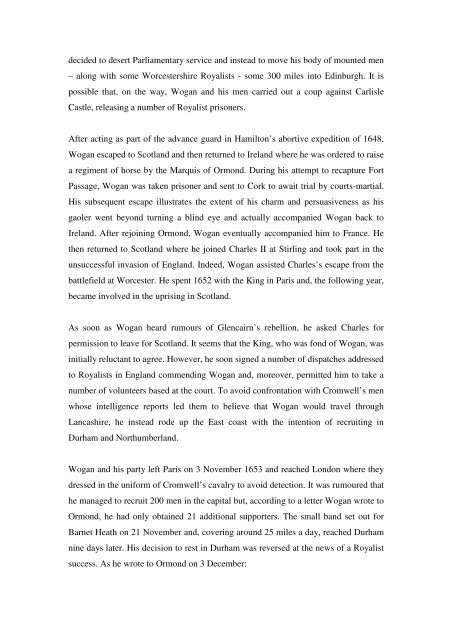The Glencairn Uprising, 1653-54 Helen Baker Department of ...
The Glencairn Uprising, 1653-54 Helen Baker Department of ...
The Glencairn Uprising, 1653-54 Helen Baker Department of ...
You also want an ePaper? Increase the reach of your titles
YUMPU automatically turns print PDFs into web optimized ePapers that Google loves.
decided to desert Parliamentary service and instead to move his body <strong>of</strong> mounted men<br />
– along with some Worcestershire Royalists - some 300 miles into Edinburgh. It is<br />
possible that, on the way, Wogan and his men carried out a coup against Carlisle<br />
Castle, releasing a number <strong>of</strong> Royalist prisoners.<br />
After acting as part <strong>of</strong> the advance guard in Hamilton’s abortive expedition <strong>of</strong> 1648,<br />
Wogan escaped to Scotland and then returned to Ireland where he was ordered to raise<br />
a regiment <strong>of</strong> horse by the Marquis <strong>of</strong> Ormond. During his attempt to recapture Fort<br />
Passage, Wogan was taken prisoner and sent to Cork to await trial by courts-martial.<br />
His subsequent escape illustrates the extent <strong>of</strong> his charm and persuasiveness as his<br />
gaoler went beyond turning a blind eye and actually accompanied Wogan back to<br />
Ireland. After rejoining Ormond, Wogan eventually accompanied him to France. He<br />
then returned to Scotland where he joined Charles II at Stirling and took part in the<br />
unsuccessful invasion <strong>of</strong> England. Indeed, Wogan assisted Charles’s escape from the<br />
battlefield at Worcester. He spent 1652 with the King in Paris and, the following year,<br />
became involved in the uprising in Scotland.<br />
As soon as Wogan heard rumours <strong>of</strong> <strong>Glencairn</strong>’s rebellion, he asked Charles for<br />
permission to leave for Scotland. It seems that the King, who was fond <strong>of</strong> Wogan, was<br />
initially reluctant to agree. However, he soon signed a number <strong>of</strong> dispatches addressed<br />
to Royalists in England commending Wogan and, moreover, permitted him to take a<br />
number <strong>of</strong> volunteers based at the court. To avoid confrontation with Cromwell’s men<br />
whose intelligence reports led them to believe that Wogan would travel through<br />
Lancashire, he instead rode up the East coast with the intention <strong>of</strong> recruiting in<br />
Durham and Northumberland.<br />
Wogan and his party left Paris on 3 November <strong>1653</strong> and reached London where they<br />
dressed in the uniform <strong>of</strong> Cromwell’s cavalry to avoid detection. It was rumoured that<br />
he managed to recruit 200 men in the capital but, according to a letter Wogan wrote to<br />
Ormond, he had only obtained 21 additional supporters. <strong>The</strong> small band set out for<br />
Barnet Heath on 21 November and, covering around 25 miles a day, reached Durham<br />
nine days later. His decision to rest in Durham was reversed at the news <strong>of</strong> a Royalist<br />
success. As he wrote to Ormond on 3 December:
















